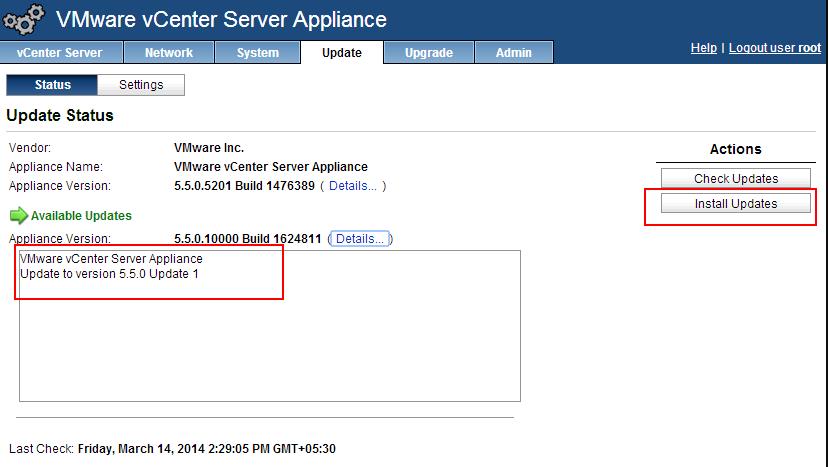

- #VCENTER 6.5 APPLIANCE DOWNLOAD INSTALL#
- #VCENTER 6.5 APPLIANCE DOWNLOAD 64 BIT#
- #VCENTER 6.5 APPLIANCE DOWNLOAD UPDATE#
- #VCENTER 6.5 APPLIANCE DOWNLOAD FULL#
- #VCENTER 6.5 APPLIANCE DOWNLOAD SOFTWARE#
The first validation of the vcsa install can be done by pulling up the vCenter Appliance Administration interface ( VAMI). VCenter Appliance Administration Interface If you see certificate or thumbprint errors, the most common problem is DNS not being both name and reverse resolvable. Log in as: Successfully executed Task 'ApplianceLoginSummaryTask: ProvideĪppliance login information.' in TaskFlow 'esxi' at 04:40:34 The install will take 20+ minutes, and there will be lots of output to the console, but in the end you should see output similar to below.

Sudo lin64/vcsa-deploy install -no-ssl-certificate-verification -accept-eula -acknowledge-ceip ~/vcsa-esxi.json Go into the “vcsa-cli-installer directory and run the installer like below, specifying our json file in the home directory.

#VCENTER 6.5 APPLIANCE DOWNLOAD FULL#
The full list of templates available is located on the ISO at “vcsa-cli-installer/templates/install”, the template we are basing this article on is “embedded_vCSA_on_ESXi.json”ĭownload this json from my github project and place it into the home directory of inst1. The cli installer is driven by values you set on a json file. If you have DNS configured as suggested using the dnsmasq for the default virtual network, then “/etc/nf” should be pointing at 192.168.122.1. Sudo mount -t iso9660 -o loop /dev/cdrom /media/isoīecause it is so important to the install process, we need to ensure we have full name and IP resolution from this host. Mount CDROM within OS sudo mkdir -p /media/iso Virsh change-media inst1 $cdrom ~/Downloads/VMware-VCSA-all-6.7.0-16708996.iso -insert cdrom=`virsh domblklist inst1 -details | grep cdrom | awk ` When it gets to the end of the installation process, and asks you to eject the CDROM and restart, go ahead and run the following virsh commands at a console before pressing on the Ubuntu installer screen. This whole process should take around 15-30 minutes.
#VCENTER 6.5 APPLIANCE DOWNLOAD SOFTWARE#
When you get to Software selection, choose “Basic Ubuntu server” and “OpenSSH server”. Go through the full Ubuntu installation process accepting all defaults in order to build a basic Ubuntu guest OS. virt-install -virt-type=kvm -name=inst1 -ram 2048 -vcpus=1 -virt-type=kvm -hvm -cdrom ~/Downloads/mini.iso -network network=default -graphics vnc -disk pool=default,size=30,bus=virtio,format=qcow2 -noautoconsole -force Then create a small KVM guest OS named “inst1”. Understand this is a throwaway VM only being used to install vcsa, after which it can be discarded.įirst, download the Ubuntu network installer named “mini.iso” to your Downloads directory. We are going to use a KVM virtualized Ubuntu host named ‘inst1’ to mount the vCenter ISO as the CDROM, and run the command line installer.
#VCENTER 6.5 APPLIANCE DOWNLOAD 64 BIT#
The vcsa install can be done from either a Windows or Linux 64 bit host with network connectivity to ESXi. This can be decreased later for lab environments.ĭownload an evaluation version of vCenter, which comes as a 3.4Gb ISO file. Take note that the vcsa installer even in ‘tiny’ mode mandates the ESXi host have 10Gb of memory and 2 vCPU. You can install KVM on your Ubuntu host and then install ESXi on top of KVM. In this series of articles I am virtualizing on top of KVM. The first prerequisite is obviously an instance of ESXi 6.7.

This will be done with the help of a staging KVM Linux guest (‘inst1’) where we will mount the vsca ISO downloaded from and run the vcsa CLI installer. In this article, we will deploy the vCenter Server Appliance (vcsa) on top of the ESXi server as its own virtualized guest OS. In my last article we took KVM running on bare metal and deployed an ESXi host on top of it. If you have just virtualized the VMware ESXi 6.7 server on top of KVM, the next step will be to install vCenter 6.7 for its centralized control and additional feature set and management capabilities.
#VCENTER 6.5 APPLIANCE DOWNLOAD UPDATE#
Update Nov 2021: I have written a newer article that deploys vCenter 7.0.


 0 kommentar(er)
0 kommentar(er)
